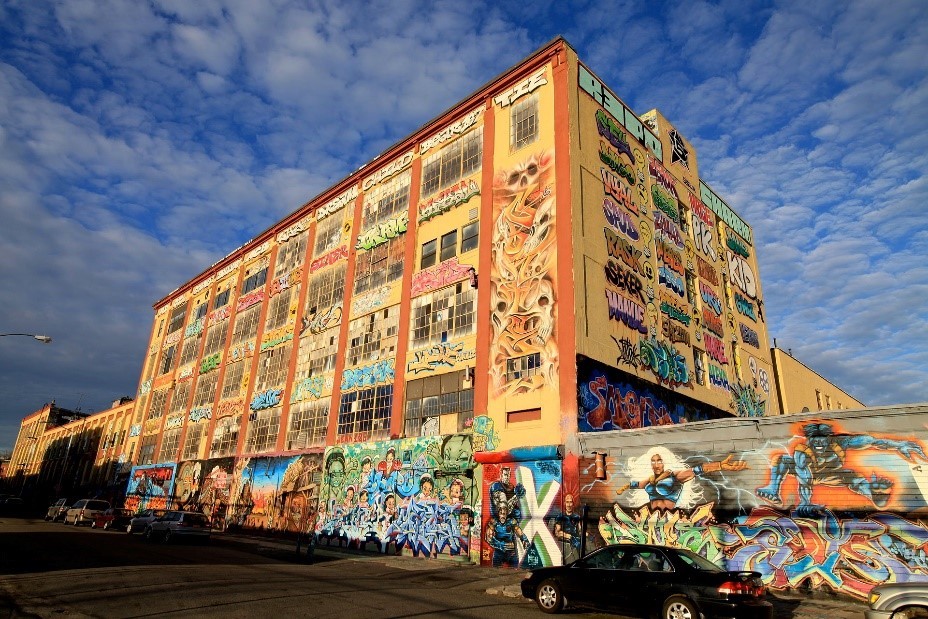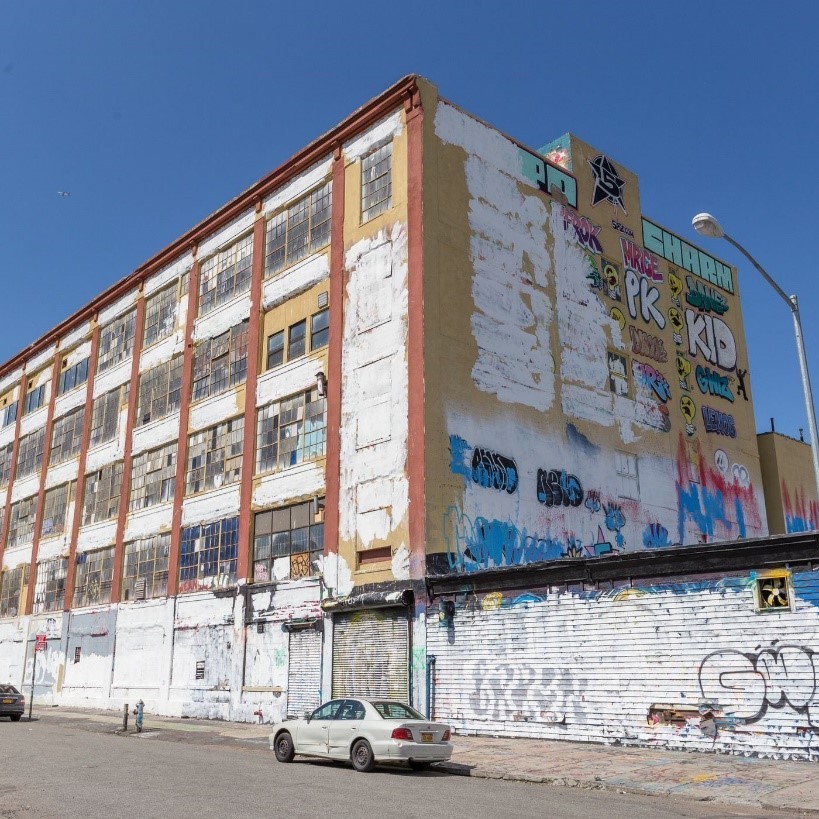In a rare decision interpreting the Visual Artist Rights Act ("VARA"), the Second Circuit affirmed an award of $6.75 million in statutory damages to several graffiti artists whose work was destroyed in "pure pique and revenge" by the owner of the building on which the work appeared.
Passed in 1990, VARA amended the Copyright Act to recognize limited "moral rights" for certain types of visual art artists. Specifically, VARA allows "the author of a work of visual art" the right "to prevent any destruction of a work of recognized stature." 17 U.S.C. § 106A(a)(3)(B). Damages under VARA are governed by general copyright law, permitting actual damages or statutory damages ranging from $300 to $30,000 per work that can be increased up to $150,000 per work for willful violations. § 504(c)(1)-(2).
This case centered on the application of VARA to a series of dilapidated warehouses in Queens, New York, known as 5Pointz. In 2002, the owner of these warehouses—Jerry Wolkoff—enlisted the help of renowned graffiti artist Jonathan Cohen to turn the warehouses into an art exhibit space. Cohen proceeded to serve as a curator for the graffiti art at 5Pointz, which featured both temporary and permanent works, and developed 5Pointz into a global epicenter for graffiti art. The art attracted thousands of daily visitors, including many celebrities, received extensive media coverage, and housed approximately 10,650 works of art over its lifespan. An image of 5Pointz before this litigation is shown below:

In May 2013, Cohen learned that Wolkoff intended to demolish 5Pointz to build a luxury apartment building. After his application to register 5Pointz as a site of cultural significance was denied, Cohen and numerous other artists filed suit against Wolkoff on October 10, 2013 under VARA to prevent the destruction of 5Pointz. On October 17, 2013, Cohen successfully obtained a temporary restraining order preventing the destruction of the building until November 12, 2013. In the meantime, Cohen sought a preliminary injunction, but the court issued a minute order on November 12, 2013 denying such relief, noting a full opinion would follow. That same day, Wolkoff banned the artists from entering 5Pointz and refused them permission to recover any work that could be removed. Several nights later, before the Court issued its full written decision, "Wolkoff set out in the dark of night" to whitewash all the artwork in 5Pointz "using the cheapest paint available, standing behind his workers and urging them to 'keep painting' and 'paint everything.'' An image of 5Pointz after it was whitewashed is shown below:

On November 20, 2013, the court issued its opinion denying the preliminary injunction, stating that whether the 5Pointz artwork had achieved "recognized stature" was an issued better reserved for trial. The court recognized the risk that the artwork would be destroyed absent the PI—indeed, it had already been destroyed when the opinion issued—but found that the monetary damages available under VARA could remedy any injury proved at trial.
Nearly 5 years after the whitewashing, on February 18, 2018, the district court issued its decision, finding that 45 of the 49 5Pointz works at issue achieved "recognized stature" under VARA and Wolkoff willfully violated VARA by destroying those works. The court awarded $6.75 million in statutory damages to Cohen and the other artists. Wolkoff immediately appealed the decision.
The primary question on appeal was whether the works of art at 5Pointz were of "recognized stature" under VARA. The Second Circuit defined "recognized stature" as a work "of high quality, status, or caliber that has been acknowledged as such by the relevant community."
The Second Circuit also offered guidance on how this definition should be applied. According to the Second Circuit, a work's "artistic quality" is the most important factor as to whether a work is of "recognized stature." But it also noted that a work created or curated by an artist whose merits have been recognized by another prominent artist, museum curator, or art critic is more likely to be of recognized stature. Further, the court explained that the site of a work also bears on its stature. For example, appearance at a major site such as the Louvre all but ensures the work will be recognized and appreciated by the art community. As for the relevant community, the court determined that such community is comprised of the "artistic community," which consists of "historians, art critics, museum curators, gallerists, prominent artists, and other experts." The court was careful to note that "the personal judgment of the court is not the determinative factor of the court's analysis."
The Second Circuit also held that, contrary to Wolkoff's arguments, a work need not be permanent to achieve "recognized stature;" temporary works also qualify. In coming to this conclusion, the court looked to the text of VARA, which did not differentiate between "permanent" or "temporary" works even though Congress explicitly included other durational limits in VARA (i.e. modification of a work as a result of passage of time is not a violation). As such, the court refused to create a distinction that Congress apparently did not intend. The court also noted two real-world examples to emphasize its holding. First, the court cited a brief 2005 exhibition in Central Park where two artists installed 7,503 orange-draped gates in Central Park. While this exhibition lasted only two weeks, it was subject to extensive critical acclaim and, in the court's view, achieved "recognized stature." The court also cited the rise to prominence of "street art," specifically referencing the street artist Banksy, who appeared alongside President Obama and Steve Jobs in Time magazine's list of the world's 100 most influential people in 2010.
Finally, the Second Circuit analyzed VARA's waiver provisions, which allow an artist to waive their VARA rights "if the author expressly agrees to such waiver in a written instrument signed by the author." The statute goes on to say that rights associated with visual art incorporated as part of a building can only be waived if the written instrument "specifies that installation of the work may subject the work to destruction, distortion, mutilation, or other modification, by reason of its removal." Wolkoff never entered into any written agreement with any of the 5Pointz artists, including Cohen, waiving their VARA rights should the building artwork be destroyed, mutilated, or otherwise torn down. And the court held that mere knowledge by an artist that the building might eventually be torn down was insufficient to terminate the artist's VARA rights. Making matters worse, Wolkoff also failed to provide the artists 90 days to remove any art from the building that could be removed prior to destruction, violating another black-and-white provision of VARA.
Having affirmed the district court's finding related to Wolkoff's VARA violations, the Second Circuit concluded its opinion with a bang by upholding the district court's award of $6.75 million in enhanced statutory damages based on Wolkoff's willful violation of VARA. A willful violation occurs when a defendant had knowledge that its conduct was unlawful or recklessly disregarded that possibility. The Second Circuit based its decision on evidence that Wolkoff admitted his awareness that the artists were pressing VARA claims and that VARA required 90-day notice before destroying any visual art. The court also emphasized the district court's finding that, while difficult to quantify the monetary loss of the 5Pointz artists, these artists suffered substantial damage to their careers through loss of future opportunities and acclaim, which could be rectified in part through statutory damages. Most troubling to the Second Circuit was Wolkoff's decision to whitewash 5Pointz at all when nothing in the record indicated that Wolkoff would have suffered any damage had he allowed the art to remain until the scheduled demolition of the building. In the district court's words, this was nothing more than an "act of pure pique and revenge" towards the artists who had sued him. Under these circumstances, the Second Circuit found that a maximum statutory award would serve to best deter future similar violations by Wolkoff and other similarly-situated third parties.
This article previously appeared here on April 8th, 2020.
The content of this article is intended to provide a general guide to the subject matter. Specialist advice should be sought about your specific circumstances.

